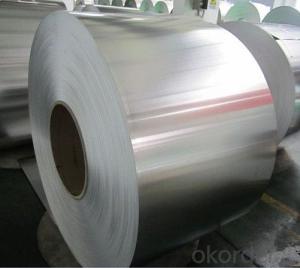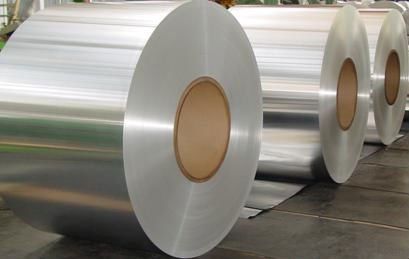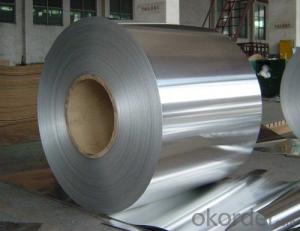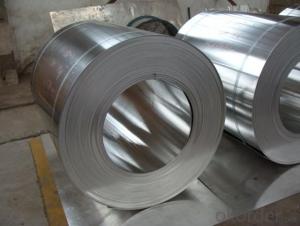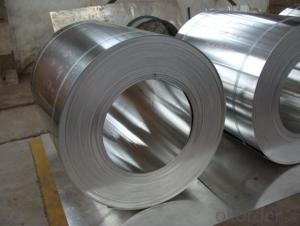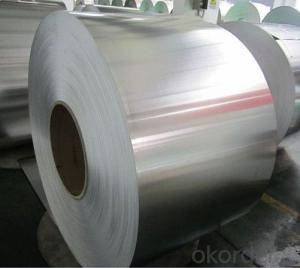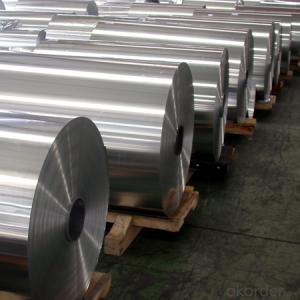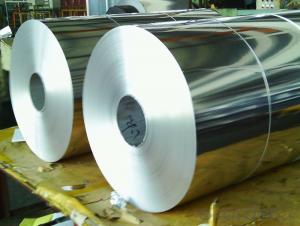S600 Aluminum Coil Price 5052 Temper H32 0.4mm 0.5mm 0.6mm Thick Aluminum Roll
- Loading Port:
- Shanghai
- Payment Terms:
- TT OR LC
- Min Order Qty:
- 5 m.t.
- Supply Capability:
- 6000 m.t./month
OKorder Service Pledge
OKorder Financial Service
You Might Also Like
Specification
5052 Temper H32 0.4mm 0.5mm 0.6mm Thick Aluminum Roll
Applications:
Aluminum foil roll is widely used in construction,decoration,hardware,
electric appliances,machinery and other industrial and civil purposes,
such as electronic capacitor,composite cooker,rice cooker,refrigerator,
computer casting,telecommunication,equipment,lamp shade,air conditioner,
cosmetics cover and so on.
Or it can be made as customers’ requirement.
Specifications
color aluminum coil
1000 series 1100 10160 1200
surface could be: Brushed, drawing, embossed, printing
color: red,
color aluminum coil
.Alloy type: 1050/1060/1100/1350
2.Temper: H16, H18, H22, H24
3.Thickness range: 0.1mm-4mm
4.Width range: 25mm-1600mm
5.Surface:finish: bright & smooth surface, without flow lines, slight oiled to avoid white rusting.
6.Quality material:totally free from such defefects as roll marks, edge damager, camber, white rust, oil patches, holes, break lines,
color aluminum coil
Name |
color aluminum coil |
Alloy or not | yes |
Alloy | 1100H16/18, 3003H24,3003H26,3005H26,8011,3004,3105,5005,etc. |
Thickness | 0.1-4mm |
Width | ≤1600mm |
MOQ | 5T |
Coating finish | Brushed, drawing, embossed, printing |
Color | As to code RAL |
Surface | Embossed,Mill Finish,Coated,Brushed |
Gloss | 10-90%(EN ISO-2813:1994) |
Total coating thick | PVDF27 ~35micron |
Polyester18~27micron(EN ISO-2360:1995) | |
Coating hardness | 2H |
Adhesion | 5B (EN ISO-2409:1994) |
Impact resistance | No cracking and peeling (A.S.T.M D2794-1993) |
Flexibility (T-bend) | 0T- 2T |
MEK resistance | 100 |
Certification | ISO9001:2000, CE, SGS |
Coil's standard diameter | 1100mm |
Inner Diameter | 405mm/505mm |
Coil's standard weight | 2000kgs |
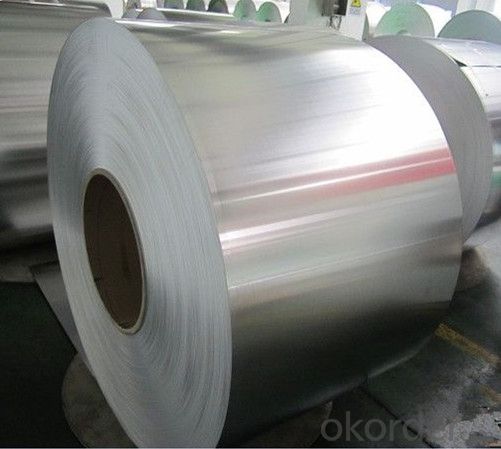
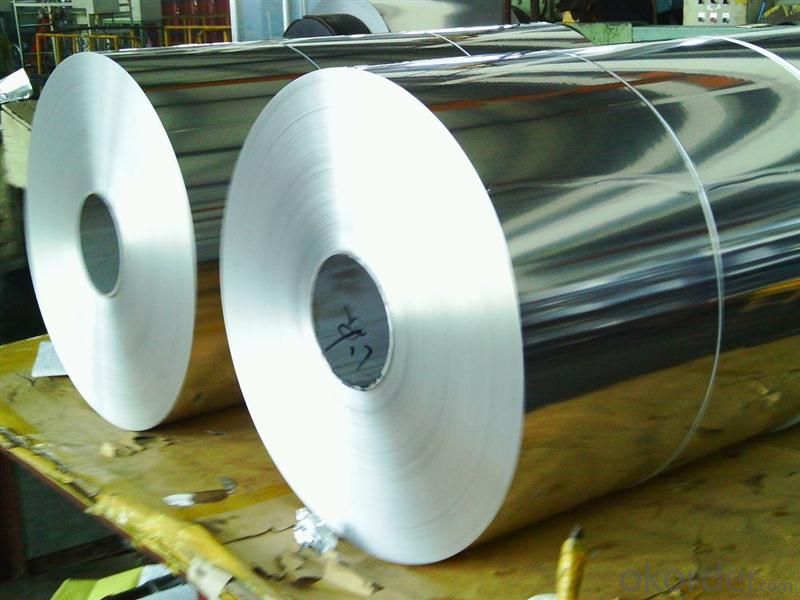
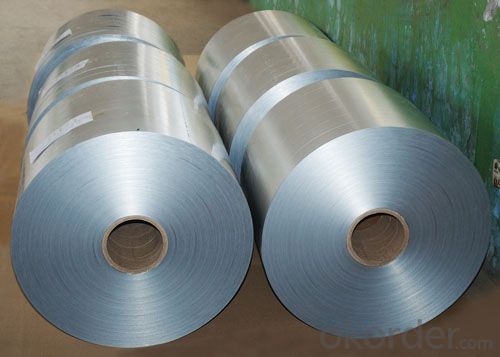
- Q: This question asks about the environmental friendliness of aluminum coils.
- <p>Aluminum coils are considered environmentally friendly for several reasons. They are highly recyclable, with the recycling process requiring significantly less energy compared to producing new aluminum. This reduces greenhouse gas emissions and conserves resources. Additionally, aluminum is a non-toxic material that does not leach harmful substances into the environment. However, the environmental impact also depends on the production process, which can consume energy and generate emissions. Overall, when properly recycled, aluminum coils have a lower environmental footprint than many other materials.</p>
- Q: Is it possible to construct a bird feeder using an aluminum coil?
- <p>Yes, you can use an aluminum coil to make a bird feeder. Aluminum is lightweight, durable, and resistant to rust, making it a suitable material for outdoor use. To create a bird feeder, you can form the coil into a hanger or support structure, then attach a feeding platform or container where birds can access the food. Ensure the structure is stable and safe for birds to perch and feed. Remember to use appropriate tools and safety measures when working with aluminum, and consider painting or coating the coil to enhance its appearance and protect it from the elements.</p>
- Q: How do aluminum coils contribute to energy savings in buildings?
- Aluminum coils are an essential component of HVAC (Heating, Ventilation, and Air Conditioning) systems in buildings, and they play a significant role in contributing to energy savings. Firstly, aluminum coils are highly efficient in transferring heat. HVAC systems use these coils to facilitate the exchange of heat between the indoor and outdoor environments. Aluminum's thermal conductivity allows for quick and efficient heat transfer, reducing the energy required to heat or cool a space. This means that HVAC systems equipped with aluminum coils can achieve the desired indoor temperature more efficiently, leading to energy savings. Moreover, aluminum coils are lightweight and have excellent corrosion resistance. This property ensures the longevity and durability of the HVAC system, reducing the need for frequent replacements. By having a longer lifespan, the energy and resources used in manufacturing new coils are saved, resulting in reduced energy consumption and environmental impact. Furthermore, aluminum coils are highly recyclable. When an HVAC system reaches the end of its life cycle, the aluminum coils can be easily recycled and repurposed. Recycling aluminum requires significantly less energy compared to producing new aluminum from raw materials. By promoting recycling, energy is conserved, and greenhouse gas emissions are reduced. Additionally, aluminum's reflective properties contribute to energy savings in buildings. When used in HVAC systems, aluminum coils can reflect and deflect sunlight, reducing the amount of heat absorbed by the building. This reduces the workload on the HVAC system, resulting in lower energy consumption and increased energy efficiency. In summary, aluminum coils contribute to energy savings in buildings through their high thermal conductivity, lightweight and durable nature, recyclability, and reflective properties. By using aluminum coils in HVAC systems, buildings can achieve optimal temperature control with reduced energy consumption, leading to significant energy savings and a more sustainable environment.
- Q: The user is asking if it's possible to use a punching machine to create holes in aluminum coils.
- <p>Yes, you can use a punching machine to punch holes in aluminum coils. Punching machines are designed to cut or create holes in various materials, including metals like aluminum. However, the type of punching machine and the specific settings will depend on the thickness and hardness of the aluminum coils. For thicker or harder aluminum, a more robust machine with appropriate dies may be necessary. Ensure that the machine is capable of handling the material's properties to avoid damage or inefficiencies in the punching process.</p>
- Q: What are the common surface treatments applied to aluminum coils?
- To enhance the durability, appearance, and resistance to corrosion of aluminum coils, various common surface treatments can be applied. Anodizing is one such treatment, involving the creation of an oxide layer through an electrochemical process. This not only protects against corrosion but also allows for the use of different colors and finishes. Painting or coating is another popular treatment option. Aluminum coils can be painted in a wide array of colors and coatings, providing extra protection against corrosion and improving their visual appeal. These coatings can be applied using methods like powder coating or liquid spray, offering varying levels of durability and resistance to environmental factors. Laminating is a process where a protective film or layer is added to the surface of aluminum coils. This film enhances resistance against scratches, abrasions, and UV rays, making the coated coil suitable for outdoor applications. Embossing or texturing is another commonly used surface treatment for aluminum coils. This involves creating patterns, designs, or textures on the surface, enhancing visual appeal and providing additional structural strength and grip. In conclusion, the selection of a surface treatment for aluminum coils depends on specific requirements, including desired appearance, durability, and environmental factors. It is important to consider factors like corrosion resistance, weatherability, and aesthetics when choosing the appropriate treatment.
- Q: How are aluminum coils used in the aerospace industry?
- Aluminum coils are widely used in the aerospace industry for various applications such as aircraft structures, wings, fuselages, and engine components. The high strength-to-weight ratio of aluminum makes it an ideal material choice for these applications, as it helps reduce the overall weight of the aircraft while maintaining structural integrity. Additionally, aluminum coils can be easily formed, welded, and machined, allowing for efficient manufacturing processes.
- Q: What are the different surface treatments applied to aluminum coils?
- Aluminum coils can undergo various surface treatments to enhance their appearance, protect against corrosion, and improve performance. Some commonly used surface treatments for aluminum coils are: 1. Anodizing: By subjecting aluminum to an electrochemical process, an oxide layer is formed on the surface, boosting corrosion resistance and providing an attractive finish. Anodized aluminum coils are available in a wide range of colors and finishes. 2. Painting: Paint is applied to the surface of aluminum coils, offering a decorative finish and added corrosion resistance. Painted aluminum coils find frequent use in architectural applications where aesthetics are crucial. 3. Laminating: A protective film is applied to the surface of aluminum coils, forming a barrier against scratches, abrasion, and UV radiation. Laminated aluminum coils are commonly employed in applications that require durability and weather resistance. 4. Polishing: Aluminum coils are buffed to create a smooth and shiny finish, enhancing appearance and corrosion resistance. Polished aluminum coils are often used for decorative purposes, providing a luxurious appearance. 5. Brushing: Aluminum coils undergo a mechanical process to create fine parallel lines on the surface, resulting in a brushed or satin finish that can hide imperfections and scratches. Brushed aluminum coils are often chosen for applications that require a modern and sleek appearance. Ultimately, the selection of a surface treatment for aluminum coils depends on specific application requirements and desired aesthetics. Each treatment offers unique advantages in terms of appearance, corrosion resistance, and durability, enabling manufacturers and designers to choose the most suitable option for their needs.
- Q: Can aluminum coils be used in roofing or cladding systems?
- Yes, aluminum coils can be used in roofing or cladding systems. Aluminum is a lightweight and corrosion-resistant material, making it suitable for these applications. It offers durability, flexibility, and ease of installation, making it a popular choice in the construction industry.
- Q: Describe the process of rolling aluminum coil in a few sentences.
- <p>The process of rolling aluminum coil involves several key steps. Initially, aluminum ingots are heated to a specific temperature to make them pliable. Then, they are passed through a series of rolling mills where the ingots are pressed and shaped into thin sheets or coils. This process reduces the thickness and increases the length and width of the material. During rolling, the aluminum may be annealed to improve its ductility and strength. After rolling, the aluminum coil is cooled, cleaned, and inspected for quality. The final step includes coiling the rolled aluminum into manageable rolls for storage and transportation. This process is critical for producing aluminum coils used in various industries such as construction, automotive, and packaging.</p>
- Q: What are the different finishes available for aluminum coils?
- There are several different finishes available for aluminum coils, each offering unique properties and aesthetics. 1. Mill Finish: This is the most basic and common finish for aluminum coils. It is the natural appearance of aluminum without any additional treatment or coating. Mill finish provides a smooth and shiny surface, but it is not as resistant to corrosion as other finishes. 2. Anodized Finish: Anodizing is an electrochemical process that enhances the corrosion resistance and durability of aluminum. This finish creates a thick, protective layer on the surface of the aluminum coil, making it highly resistant to weathering, scratches, and fading. Anodized finishes are available in a range of colors and can also be customized to match specific design requirements. 3. Painted Finish: Aluminum coils can be painted with various types of coatings to achieve specific colors, textures, and levels of durability. These coatings are typically applied using a coil coating process, where the paint is evenly distributed and cured onto the surface of the aluminum. Painted finishes offer excellent color retention, weather resistance, and can be tailored to meet specific project needs. 4. Brushed Finish: This finish is achieved by mechanically brushing the surface of the aluminum coil with abrasive materials, resulting in a textured appearance. Brushed finishes provide a unique aesthetic appeal and can hide scratches and blemishes. They are commonly used in architectural applications such as interior design, signage, and furniture. 5. Embossed Finish: Embossing involves imprinting a pattern or design onto the surface of the aluminum coil. This finish adds texture and visual interest to the material, making it suitable for decorative purposes. Embossed finishes can mimic various textures, such as wood grain or stucco, and are widely used in building facades, roofing, and signage. 6. Laminated Finish: Laminating involves bonding a layer of protective film or sheet onto the surface of the aluminum coil. This finish provides additional protection against scratches, stains, and UV rays. Laminated finishes are commonly used in applications that require high durability, such as transportation, appliances, and electronic enclosures. Overall, the choice of finish for aluminum coils depends on the specific requirements of the project, including aesthetics, durability, and environmental factors.
Send your message to us
S600 Aluminum Coil Price 5052 Temper H32 0.4mm 0.5mm 0.6mm Thick Aluminum Roll
- Loading Port:
- Shanghai
- Payment Terms:
- TT OR LC
- Min Order Qty:
- 5 m.t.
- Supply Capability:
- 6000 m.t./month
OKorder Service Pledge
OKorder Financial Service
Similar products
Hot products
Hot Searches
Related keywords
